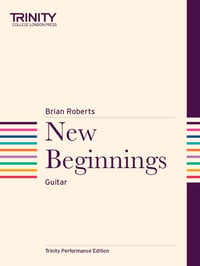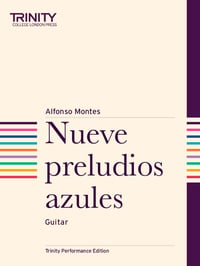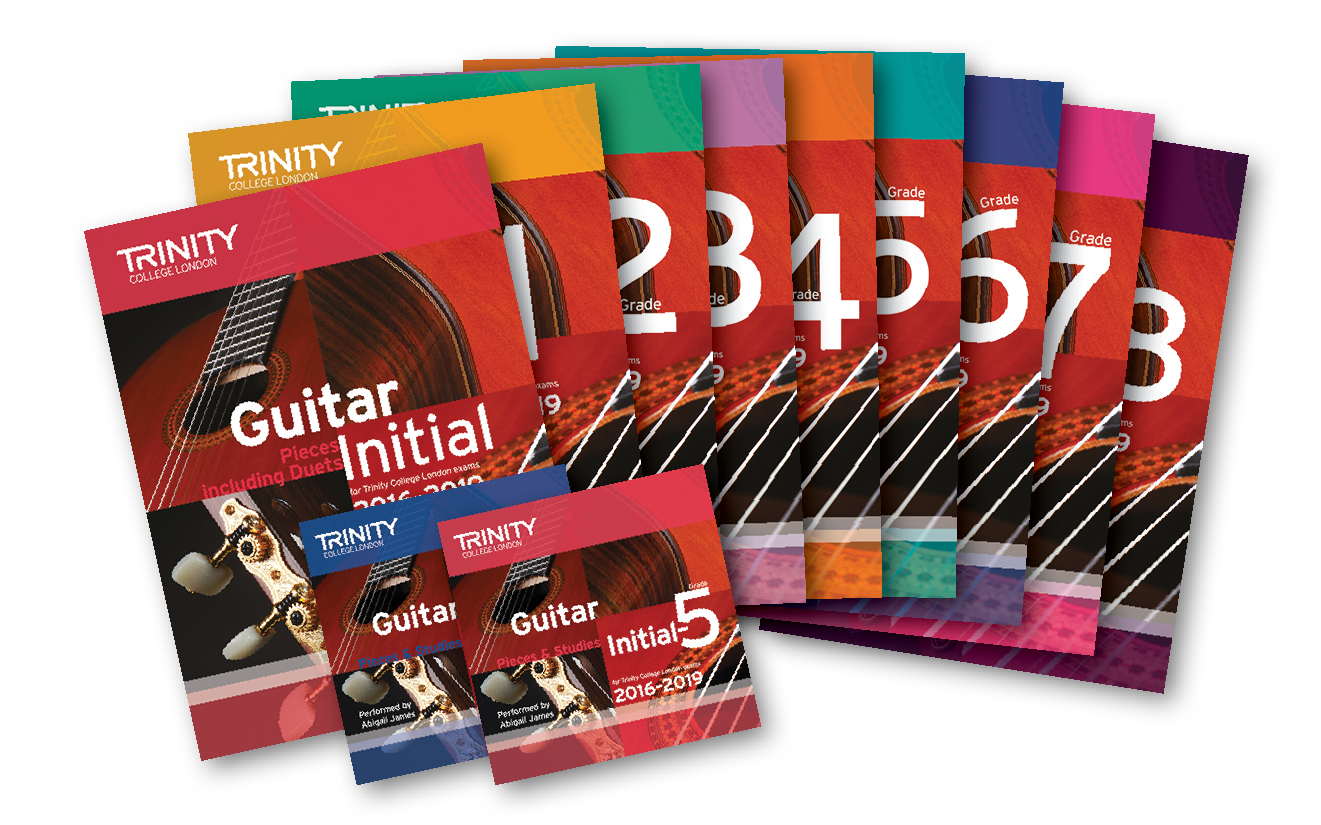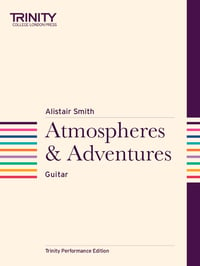Brian Roberts: New Beginnings — performance notes
Brian Roberts is a classical guitarist, composer and arranger based in Ann Arbor, Michigan. Some of his most important influences come from playing cello with the Grand Rapids Symphony, and from the many hours of listening to concerts in Vienna while studying guitar at the University of Music and Performing Arts Vienna.
New Beginnings is a collection of 21 of his pieces for solo guitar, published by Trinity College London Press.
Performance notes
By the Spring
This piece has that lighthearted feeling you have when you are sitting near a bubbling spring: joyful, but relaxed. Feel the full duration of the syncopated crotchets (from the ‘and’ of beat 1, to the ‘and’ of beat 2). The middle section moves forward and has a shifting meter from 3/4 to 6/8. In bar 17, hold the C to the end of the phrase to build a chord of F sharp, A and C.
Air of the Ages
This piece is inspired by the French music of the 15th century. Let the notes at the beginning overlap and ‘ring on’ (as indicated by l.v. in the score) to create a continuous flow and harmonically complex sound that gently rises to the B in bar 7. In bar 9, bring out the middle voice. Shape all the phrases with a singing ebb and flow.
The Celebration
Create the air of a fanfare by driving the last note in each group forward into the first note of the next group. Starting at bar 4 and 31, hold the upper notes through the following bass notes, sliding back and forth, slightly accenting the first note after the shift, giving the music a real feeling of rambunctiousness. The middle section is more lyrical so try to feel it in longer phrases.
Celtic Dance
This piece has a driving characteristic that will be enhanced by playing the dotted rhythm precisely, with an even beat. In the middle section, you can speed up slightly, pushing forward to the return.
Chimes
‘Chimes’ has a shifting meter called hemiola, beginning in bar 11. This creates an interesting rhythmic variety. Look for this hemiola characteristic throughout the piece. Feel the natural accents that are created by the melodic shapes.
Dance of the Secret Source
There is a well-known simple guitar piece in its entirety by Ferdinando Carulli hidden within the background of this piece. See if you can recognise it! Play with a light, steady beat with strong, precisely-placed slurs; this will help enhance the whimsical character of this piece.
The Golden Horse
Picture a beautiful Palomino gracefully cantering through a meadow and this will set the mood for this piece.
The Grand Entrance
Be very quick and precise with the rhythm to evoke a sense of grandness. To create an agile staccato effect in bars 6–8, lift the left hand exactly halfway through each staccato quaver.
In Good Company
Bring out the singing quality of this piece, as if you were singing with friends. At bar 17, play the upper notes lightly and smoothly in the background. The shifts in the bass melody sound best when connecting the notes by keeping the strings in contact with the frets while sliding between positions. The squeaks in the sliding shifts are almost eliminated by relaxing the fingers and slightly rolling them to break the static friction during the beginning of the shift. Experiment with the timing, amount and direction of the roll.
Into the Evening
Imagine that wonderful feeling of anticipating an enjoyable evening, as the breeze gently rises at sunset, after a hot summer day.
Jubilation
Play ‘Jubilation’ with a bright, sparkly sound. Bring out the moving voices that are fingered around the repeating open strings.
Larghetto
Play this piece with a steady solemn tempo. Sustain all the voices as much as possible across the bar lines, creating a grand orchestral mood. In the second section, move forward (as suggested by con moto) but relax in the rit. at the end of each phrase.
Misty Morning
A brushed, gentle and smooth touch for the beginning and ending phrases will enhance the feeling of this piece. The middle phrase can be played with more strength and clear articulation.
A New World
Play the first section lyrically, rising to the high point of the phrase. The second section is more exuberant and driving.
Eight Musical Miniatures
1. An Entrance of Import
Play with a strong, steady sound, with plenty of vibrato, to create a dramatic entrance. Emphasise the first beats in the 2/4 section, to bring out the rhythmic variety (akin to hemiola) and to create a solid, decisive ending.
2. Lazy Days
Sliding the left-hand fingers at the same time creates a nice special effect, because the lower note (in these cases) is heard from the left hand, before the right hand plays it.
3. High Sun, Deep Shadows
Bring out the interaction between the two voices. Playing the scale-wise figures articulately and the arpeggio figures ringing (l.v.).
4. The Shards of Stars
Playing with a crystal-clear rhythm will bring out the interesting feeling that the 2+2+3 meter creates. As in ‘In Good Company’, the squeaks in the sliding shifts can be reduced by relaxing the fingers and rolling them slightly. Again, experiment with the timing, amount and direction of the roll. Move fluently forward in bar 5.
5. Seeds of Hope
This slow piece is enhanced by building each phrase with accurate rhythm. The first is dark and intense, while the second is bright and hopeful. The third phrase starts dark, but this gives way to brightness at the very end of the piece.
6. First Light
‘First Light’ has an announcing quality. Imagine hearing a chime, like Big Ben, first thing in the morning. Play in a strong, even rhythm, including the harmonics.
7. The Little Blue Spruce
The little spruce tree is small, but mighty. Play with sombre intensity by moving the musical line gently to the high points in the phrase. In the middle section, build excitement by driving forward, releasing back, and tapering to the end of the phrase. Do this according to how you feel the energy of the notes and the shape of the line.
8. Breath
Bring out the carefree, quick-walking mood of this piece by moving lightly from chord to chord in the first section, with rhythmic precision. Start ‘running’ in the second section and drive forward, emphasising the bass, until you land back in the first section. Then (and only then), return to a carefree, walking mood to the end.
One Winter Day
The melody moves on the off-beat through much of the piece. Make sure to play it legato and lyrically, synchronising the left hand with the movement of melody notes.
The Quiet Meadow
Play with peacefulness. The open-string accompaniment notes, first on the bottom and then on the top, should be in the background. Gently build the open‑string notes as they become the melody in the final section.
Prelude no. 9
‘Prelude no. 9’ is an elegy. Play with depth and expressiveness, bringing out a spacious, lyrical, singing quality. The 7/8 starting in bars 9 and 23 is in a slightly lilting two beats per bar. In bar 19, reach for the high note, then plunge down for the beginning of the next bar.
The Stars Reflecting in the Lake
In the first section, start each figure lightly, push to the second beat, and then taper off. This phrasing is enhanced by using vibrato at the peak of each crescendo (ie on the first triplet quaver of beat 2). In the second section, sliding the left-hand fingers at the same time creates a nice special effect, because one of the notes is heard from the left hand, before the right hand plays it. In the final phrase, slide the 3rd finger on the 3rd string and lightly lift the fingers on the 6th string during the shifts.
Wandering
This simple piece sounds best with a solid, firm sound on the melody and light, brushed sound on the bass.
The White Night
‘The White Night’ can have several characters, depending on how fast you choose to play it: from peaceful and positive to flighty and sparkly. Match the intensity of playing with the speed you have chosen. Give the bass notes a slight emphasis to create a graceful feeling as they move on each minim beat.
Performance notes by Brian Roberts







